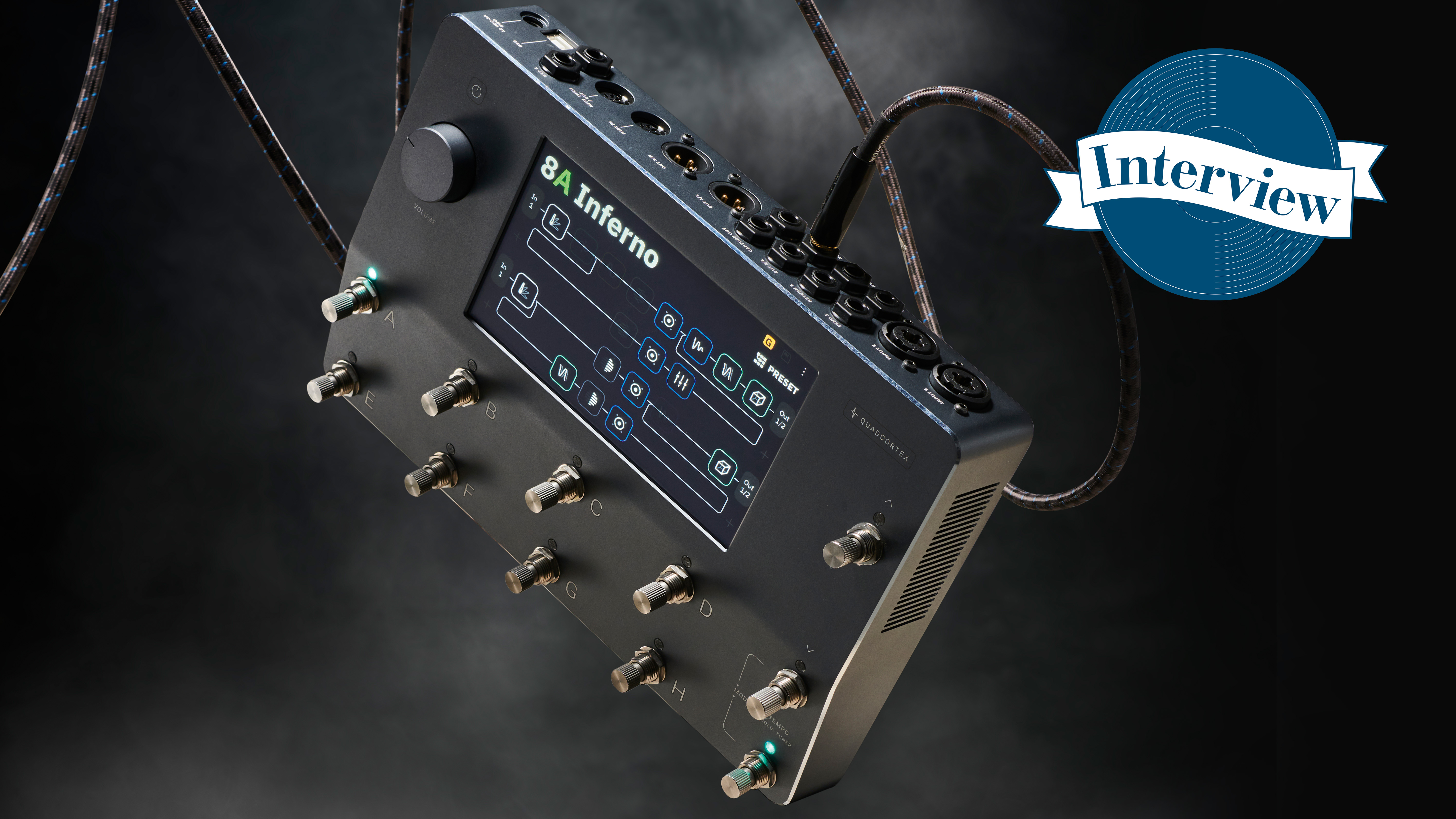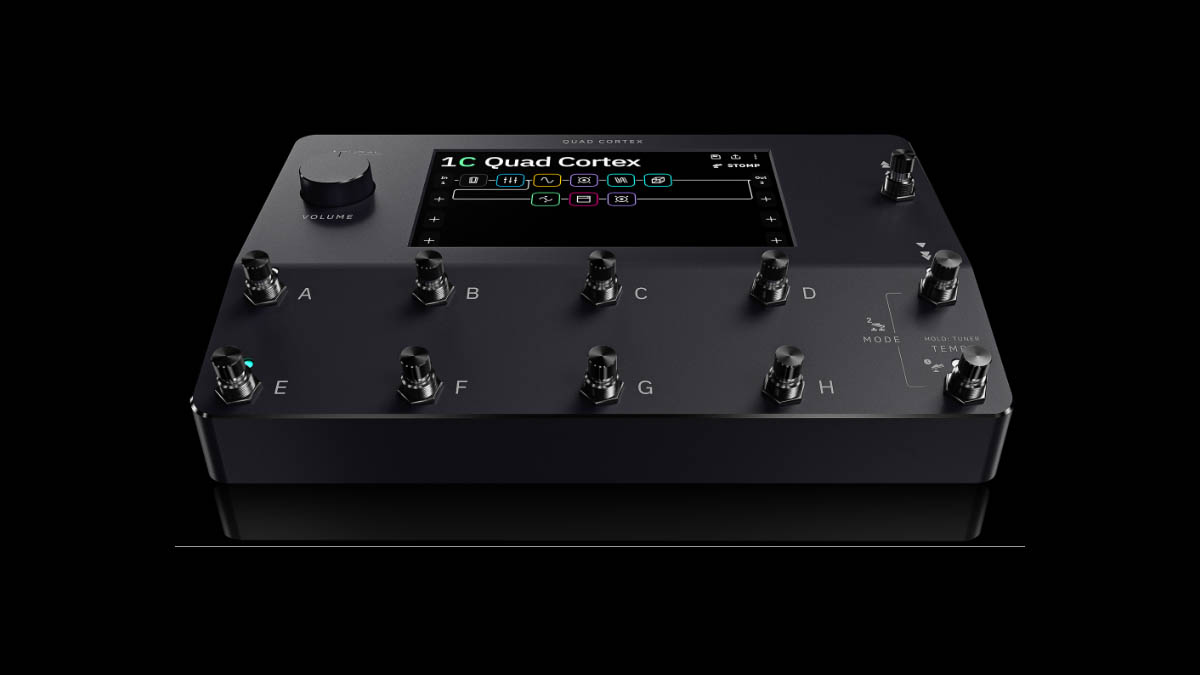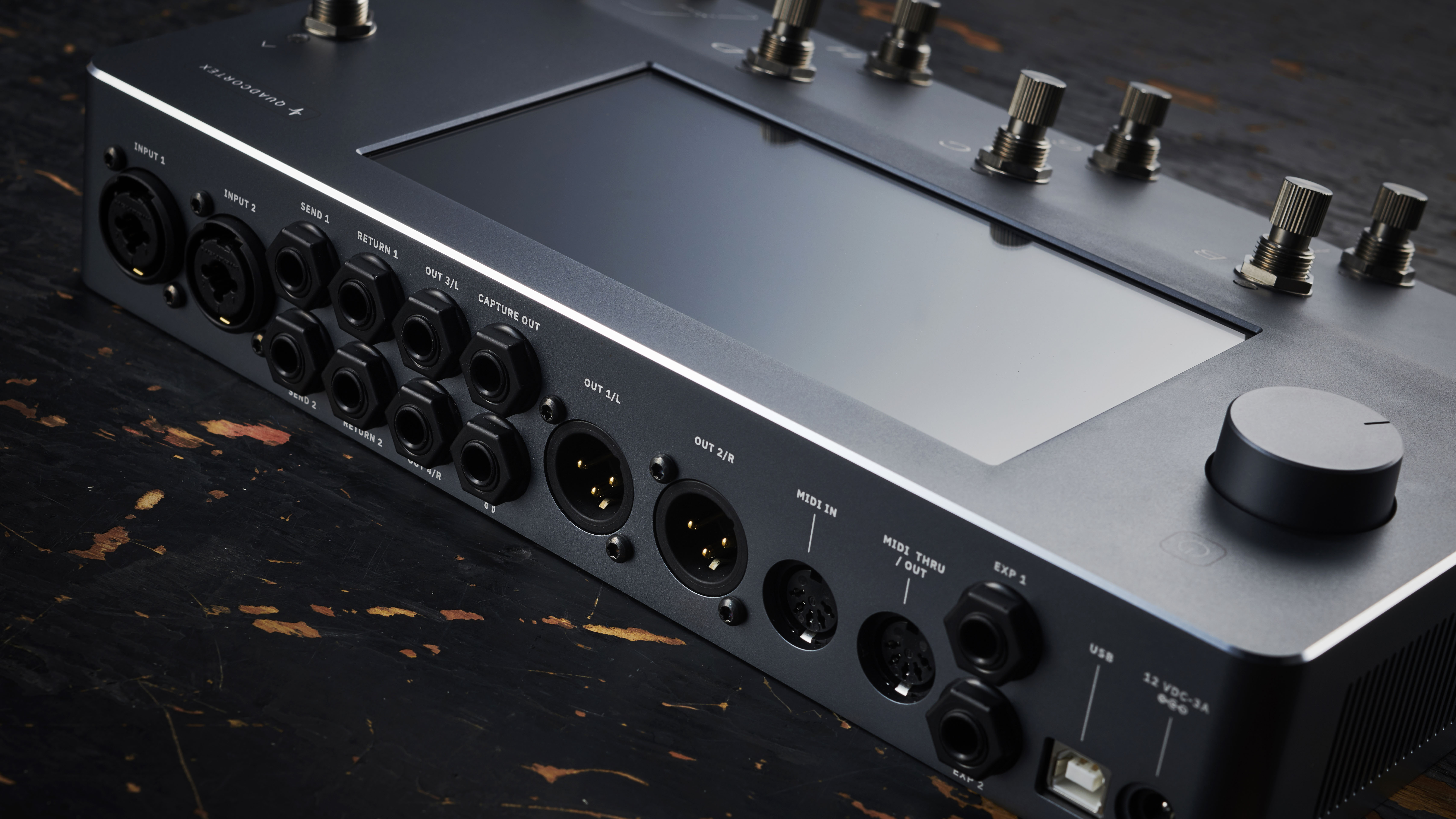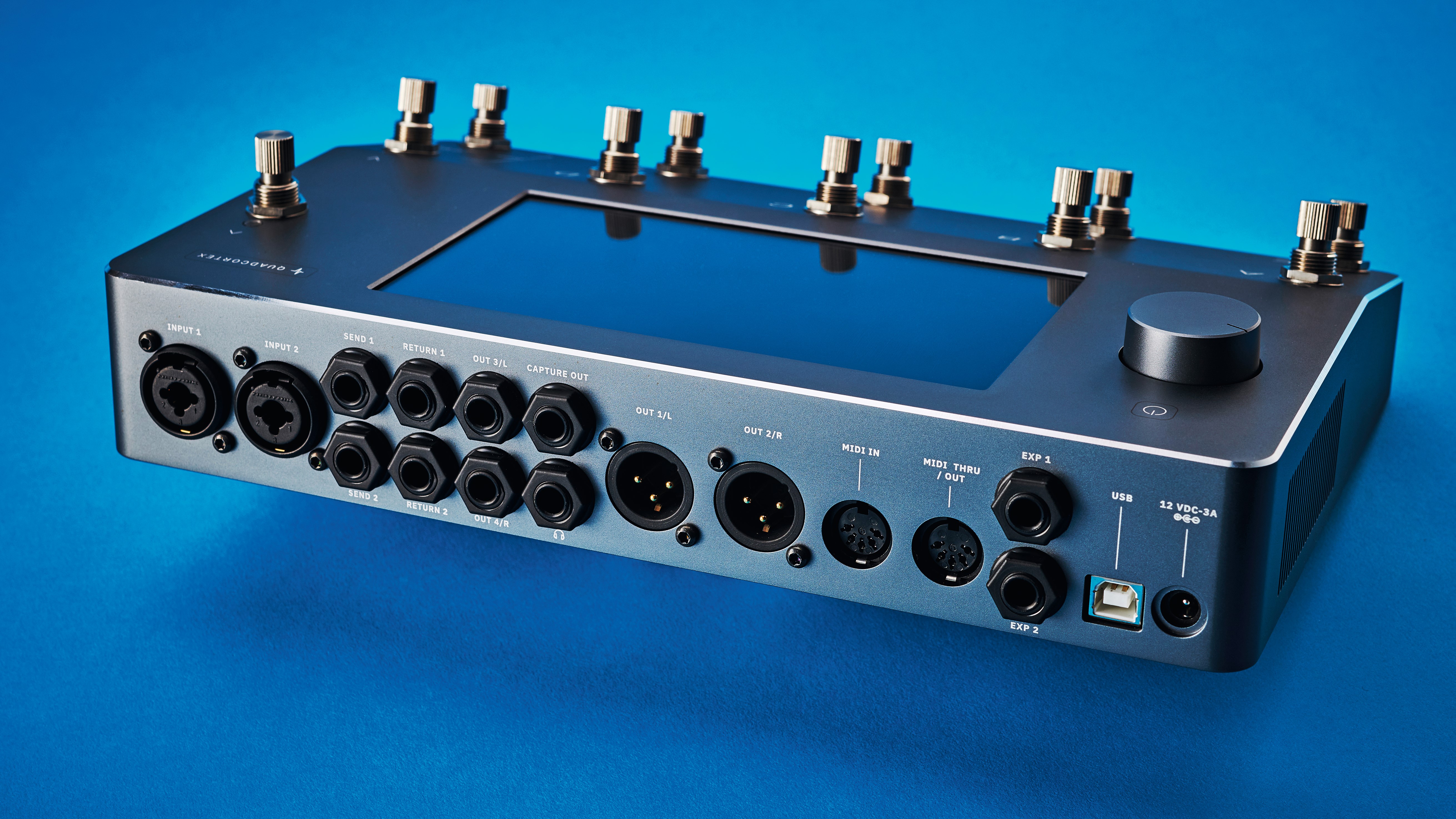Neural DSP CEO Doug Castro interview: "What I felt, until Quad Cortex came around, is that there was a false dichotomy in terms of power and usability"
The company co-founder reflects on the Quad Cortex's development, how far guitar plugins have come and promises there's a lot more to come from the modelling visionaries

Considering all that Doug Castro has done to make guitar players fundamentally change the way they think about their rig, it is funny to learn that he has only been playing the instrument for a year now.
The Neural DSP founder and CEO’s first love was bass guitar, hence why he founded Darkglass Electronics in 2009. But it was only a matter of time before he moved up an octave. Call it an occupational hazard. The man whose Quad Cortex digital amp modeller – billed as the most powerful of its kind in its class – is ushering in the electric guitar’s digital revolution is a beginner guitarist, and he loves it.
“The guys say my guitar collection looks as if I was a dentist or something!,” he laughs, dialling in on Zoom. He bought pink Fender Stratocaster and learned Snow (Hey Ho) by the Red Hot Chili Peppers. Smitten, he got a Gibson Explorer and started learning trying to pick up Cloudkicker’s Beacons.
“It’s really heavy and progressive guitar stuff, and it was impossible for me to play,” Castro says. “This was like when I was learning to play bass; I would pick my favourite Dream Theater or Symphony X song and I just learned it at half-tempo, practised at half-tempo, and every day tried to increase the BPMs by four, six, eight, and then after a couple of months of toiling away with that you might get close to the original.
“I started doing that with guitar, so with this Cloudkicker guy I would get some tabs, put on the metronome and just hammer away at it. Now I can play two or three of [his] songs at full tempo and I enjoy that very much. I am really into metal but also enjoy learning songs like the Red Hot Chili Peppers. I just like learning songs.”
A post shared by Doug Castro (@dougdarkglass)
A photo posted by on
Where does he find the time? Neural DSP, by his admission, sounds like an open-all-hours deal, particularly when the post-pandemic supply chain crunch made everyone on deck a supply chain manager for a few months. In the the worldwide scramble for parts, it was survival of the fittest. If Neural did not secure the parts to make the Quad Cortex, the factory would have been shuttered.
“It was not like we had recouped all of our millions and millions of R&D and could sit this out,” Castro says. “We had to keep production running.”
Want all the hottest music and gear news, reviews, deals, features and more, direct to your inbox? Sign up here.
It didn’t matter your title, engineer, CFO, accountant – if you had any experience in negotiating a deal you were working supply chain until the parts were secured. Castro’s phone was always on. But that was only part of the story.
To maintain production and ameliorate the risk of a part shortage, the device itself had to be redesigned once more so that it would be compatible with multiple different parts from different suppliers. “It was like going back to square one, to be honest,” Castro says. “Our pain threshold is really high at Neural.”
But now there are some blue skies. The most recent update to the Quad Cortex platform brings aboard more amp and effects options. More functionality. Castro promises much more from it in the future, and from the Archetype plugin series that paved the way for the unit.
From this perspective, he takes us back to the beginning, explaining how the idea for the Quad Cortex came together (the “horrible” early mock-ups date back to 2014/15), the role plugins played in creating the Neural brand, and the challenges of replicating authentic guitar amp tone digitally – and how artists have steered its evolution.
One of the things that differentiates Neural is this sense of user experience. In that sense, it's kind of like you are the Steve Jobs of guitar gear, bundling functionality in with that consumer tech sensibility.
“Well, thank you. I am huge fan of his. I don’t feel worth of that comparison but I appreciate the sentiment. Yeah, definitely, user experience is very important, and that actually was one of the key insights we had when we started Neural.
Our goal was to do as well or if possible slightly better than the best there was in terms of sound, but do 10x better on user experience
“All of us, all you guys, as musicians, kind of knew that, five years ago, there wasn’t much room to significantly improve the sound itself. Like, if you wanted to make a new type of synthesizer it would be really hard to come out with something that is a paradigm-shifting synthesizer.
“Or with an amp model, once you had Universal Audio and Fractal doing very accurate models that I think are 95 per cent or higher close in terms of accuracy, there is no room for a 10x improvement on sound quality.

“Our goal was to do as well or if possible slightly better than the best there was in terms of sound, but do 10x better on user experience, and just make the device very, very intuitive.
“What I felt, until Quad Cortex came around, is that there was a false dichotomy in terms of power and usability. To me, it felt like the really powerful devices that sounded really good were also really difficult to use, and the ones that were really easy and fun to use didn’t sound so good or weren’t as powerful.”

Which gives you something tangible to work towards and improve on.
“I think this was one of the key insights that enable you to pursue something with this much perseverance and stubbornness. One of the things we questioned was: why was this? Why don’t you have something that is very flexible and powerful, and sounds amazing, and at the same time is as easy to use as an iPhone? When we couldn’t find a good answer to that question we started working all in on the Quad Cortex.”
How important were the Archetype plugins in creating the brand and laying the groundwork for developing a hardware device?
“Doing the plugins was crucial. There would be no Quad Cortex if it wasn’t for the Fortin Nameless, the Archetype: Nolly and all these things. That side is where my co-founder Francisco [Cresp, Neural co-founder/CPO] comes in because he is an incredible producer and actually he is of the generation of guys who never really owned an amplifier until he was part owner of Neural. He was always using some modeller. He is younger than me. He is in his early 30s.
Doing the plugins was crucial. There would be no Quad Cortex if it wasn’t for the Fortin Nameless, the Archetype: Nolly and all these things
“We used to work together at Darkglass. He used to work at the Darkglass factory, and he told me that we should do a Darkglass plugin, ‘Because it is the standard now for bass metal recordings. I don’t know a lot of people who can justify a £400 distortion pedal but I know a lot of people who would gladly pay a 100 bucks for a plugin version of it.’
“I said, ‘That sounds great. Let’s pursue this.’ He went on and he recruited developers. I gave him information but he put all that together. And at the same time, I was thinking about the Quad Cortex, and what I wanted it to be and working with our industrial designer. I think it was six months later, late 2017, we thought, ‘Let’s do plugins, and let’s do a modeller, and let’s do it under a different brand.’”
Why a different brand?
“There are two reasons why none of this was done under Darkglass. One is that Darkglass’s ethos and reason for existing was a company of bass players for bass players, and if we started emphasising guitar products, I felt that we would only alienate our current loyal users. And also, credibility doesn’t transfer well from instrument to instrument.
I did not know how hard and expensive it would be to make the Quad Cortex. If I had known, I probably would have never jumped on it
“Your drummer’s favourite cymbal brand could make a guitar and I don’t know if his loyalty to the brand could translate to you, and make you spend your money on it. Also, this was a super-risky endeavour. I did not know how hard and expensive it would be to make the Quad Cortex. If I had known, I probably would have never jumped on it. And I knew that if it didn’t go well it could take Darkglass down with it. We had to mitigate the risk and also keep Darkglass focused on what it does, so we decided to start Neural.
“We started recruiting people in late 2017, early 2018, and in April 2018 we released the Darkglass Ultra plugin, and then in September the [Fortin] Nameless. Also, the reason why we did the plugins was because something like the Quad Cortex, it is a lot of development on a lot of verticals.
“You also have to have 100s of algorithms there that make it valuable, and we realised a plugin is one per cent of the work of that, so if you have to to the work anyway, why wait until you have 100 per cent of it done to go out to market and start building a name and generating revenue? When you have two per cent, and something that is good and valuable enough to become a standalone product, just release that as a plugin.
“With the plugins, we would start building the brand, generate some revenue and traction, and that is what enabled us to do everything. It allowed Neural to become a known brand before the Quad Cortex was ready to be announced. The revenue and traction allowed us to raise capital.
“The Quad Cortex was a black hole of money for a long while, so we are really lucky to find amazing investors who really believe in us. The traction with the plugins was the main thing. Also, luckily, my background with hardware helped, too, because a lot of great software people fail when they try to do hardware.”

From the outside, it felt like you were building towards something like the Quad Cortex. Even the design of the plugins suggested a hardware aesthetic. There was a three-dimensionality to them.
“Yeah, yeah! And the reason why is Franco [Azócar Dellepiane], the industrial designer at Neural and Darkglass. He is the only person who works at both companies, still, even though I sold Darkglass to Korg a month ago. He is a genius. He is hands-down the best industrial designer in the history of the industry and I will fight anyone to the death to defend that claim! [Laughs]
“We have been very lucky. One of our investors was also a lead designer at Apple, so he worked 15 years for Jonathan Ive, was his right-hand, he has met Steve Jobs many times, so to have people like that on your side… Actually, he is the chief designer of Bang & Olufsen. Between him leaving Apple and working at Bang & Olufsen he joined our weekly design meetings. He led them actually. We have been very lucky; we have had some of the best talent.”
One of the things that always gets brought up is that challenge that modellers don’t do breakup very well; they nail the high-gain tones, and the cleans, but in-between it can be dicey. Why is that?
“Well I have both a theory and a rebuttal, because I don’t think that’s the hardest part. But I’ll explain why that’s hard. It is very possibly that the distortion curve – the transfer curve - from an amplifier, every amplifier has its own unique distortion clipping curve, transfer function, and when you model an amplifier usually you would use a generic one, like a hyperbolic tangent for example, so you have this predetermined shape that you just try to cram into the model so that it is similar.
It is very close to the real thing
“This is very noticeable in that transition period because when it is clean, things are linear, everything is great, and once you distort the hell out of something it is a square wave essentially. It’s the in-between. If the transfer function you are using is not actually like the one on the amplifier you are trying to emulate, that is one of the areas in which it will give itself away.
“What we do is, a big part of what the Neural nets do is, based on the training signals, they just create a transfer function from scratch that just really resembles the one of the amplifier, and that gives you the transition between clean and saturation. It is very close to the real thing.”

Right. What then is the biggest challenge with amp modelling?
“Dynamic response, how it feels on the fingers. I think there are many emulations that if you reamp through them they are super-close to the amp but when you play through them they feel a bit odd.
“What is responsible for that is the energy transfer from the amp’s power supply, through the power tubes, through the output transformer, out into the reactive load, the speaker, and the elements of the power supply itself – the capacitance of the power supply.
“All of these things have these super-weird effects on the guitar signal that are noticeable and perceivable. I don’t think this is very well understood to this day, and I don’t think we will ever have good science done on this because it is just not profitable for anyone to research the output transformer.
“The companies that have world-class modelling figure it out somehow and that is part of their secret sauce. Our approach does not care because it is just measuring things and based on what we measure the model writes itself. If you can hear it and feel it, our model will take that into account, so we don’t need to understand it to recreate it.
“I am extremely biased towards the Quad Cortex. I mean, I have a kid and it’s very similar, I can tell you! [Laughs] But I think the touch response is one of the things that we are known for really well, or one of the things that I feel like we are really, really close to the real thing.
“All the amps feel, different, right? If I open my SVT or a Fender Bassman they feel different to my playing, just like the amps do, and I think that is really hard to do when you are just using filters and wave shapers to model an amplifier, which is basically what white box approaches are, the conventional way to model an amplifier.”
Are we approaching an iPhone moment for guitar tech?
“If you look at the adoption of digital solutions for guitarists in the last 10 years, it has been really good. For this, I have to give credit to some of our competitors. What Cliff [Chase] did with Fractal Audio was legitimise digital signal processing for guitar as something that was professional grade, something that was good enough for the most demanding users and professionals.
“Until then, digital was seen as a sub-par compromise to using a tube amp with a huge pedalboard. I think how Line 6 responded to that, which was to make a higher-end version of what they were already doing, not quite as good sounding as Fractal in my opinion but close enough, and with a much better user interface, that was also a great step.
“Similarly, what Kemper did, and with their own approach. We do modelling and capturing, Kemper did it with profiling. ‘Okay, instead of us modelling our amps you make profiles of yours and you get the sound you want.’ All of this, all of these companies contributed significantly to accelerate the development of digital options for guitarists. Even for the most demanding ones. We definitely wouldn’t be here if it wasn’t for what they did.
It is a considerable cultural shift for players.
“You have hardcore tube guys, they still use their tube amps, and they will probably use digital effects for delay and reverb, right? I think even that helps a bit – you can compromise a bit on the analogue-ness of your sound [Laughs] with your delay and reverb. I think I invented a word there.
“Things are definitely in a really good place right now in terms of guitarists being more open-minded to trying digital stuff, and I think also things like us, people like Universal Audio doing their part, IK Multimedia as well, providing really good solutions in the box, plugins, that has also been really, really good. I mean, 10 years ago, thinking that I could get a tone that was good enough to win a Grammy from a plugin that costs a hundred bucks for guitar? That was unbelievable.
“Now, I can tell you, a lot of really, really big bands have started using our plugins in the studio. Bands who have an unlimited budget for the new album, tons of amps and engineers, everything, and it’s like, ‘Why bother? This is just as good and much more convenient, saves time.’”

There’s also the risk of option paralysis, but then that’s offset against the joy of discovering new tones.
“The tone crafting part of playing is almost as fun as playing itself – and for some people it’s probably even more enjoyable. For people actually creating music, writing their own music, there is probably a similar sense of joy and satisfaction in not only composing and writing an amazing song but making it sound really good on the record. That is also a part of the magic of creating music.
“Both are almost like different creative disciplines. I personally love both, and most of our users who buy these types of products get a lot of enjoyment and fun from pursuing both, playing guitar and crafting the tones.”
The artist collaborations have been key. What have you learned about this technology and the sounds it needs to create from working with such a diverse range of artists, such as Cory Wong, Tim Henson, John Petrucci and so on?
“Every artist pushes us in a different way. The products look the same because they were developed by the same people but at the same time they reflect the essence of different artists. They all push us really hard – although uncomfortable, and difficult when you are on a tight deadline releasing a plugin, it has made us a better company for it, every single time.
“And some of these people are incredibly nice, like Cory Wong, Tim Henson, Plini, John – amazing people. Everyone is super-friendly and polite, but when it comes to their product, if they really want something and they’re not happy with their prototypes, they will dig in and say, ‘Guys, I need this to be better than what you’ve sent me.’
“That’s tough to hear but it’s great when it happens because we always figure it out and in the end we are happy – we have made a better product. Being pushed by these people is great.”
Finally, what’s can you say about the future of the Quad Cortex? It is a product that looks like it has a long lifespan, that’s still young, that can accrue functionality as you develop the software.
“Yeah, there is a lot more we want to do with it, and we are working very hard to improve and complete the platform as fast as we can. I think by the end of the year it will be what I’d consider quite mature, and happy with the features that are there, and then it’s I’ll keep adding new content all the time – new models, new captures, new everything. And then, once that’s settled, we can refine and do things that are maybe more unexpected or less orthodox.
The tone crafting part of playing is almost as fun as playing itself – and for some people it’s probably even more enjoyable
“We have lots of crazy ideas. But it’s like you have have to eat your greens before you get dessert! [Laughs] You have to do your chores before you play videogames. You need to deliver what you told people you’d deliver, and once it’s there and it’s great then we’ll get a bit crazy and have more fun with it. I mean, it’s a computer that has a lots of ins and outs so it can become anything that you want it to be, and we look forward to exploring that hopefully early next year.”
- See Neural DSP for more.
Jonathan Horsley has been writing about guitars and guitar culture since 2005, playing them since 1990, and regularly contributes to MusicRadar, Total Guitar and Guitar World. He uses Jazz III nylon picks, 10s during the week, 9s at the weekend, and shamefully still struggles with rhythm figure one of Van Halen’s Panama.
